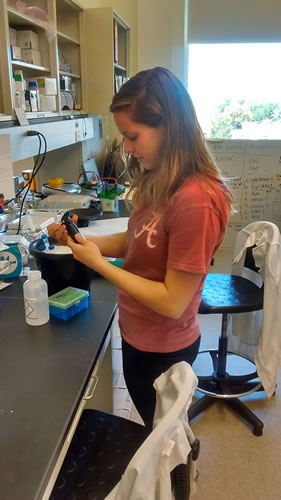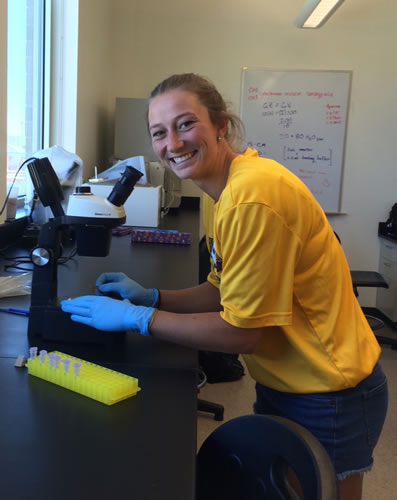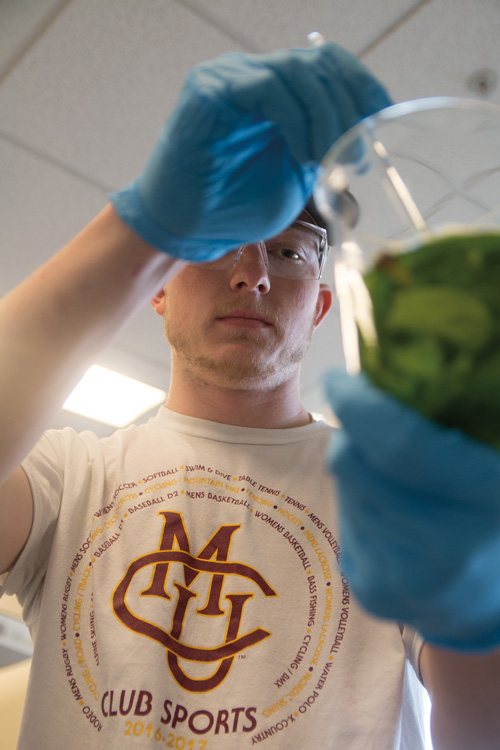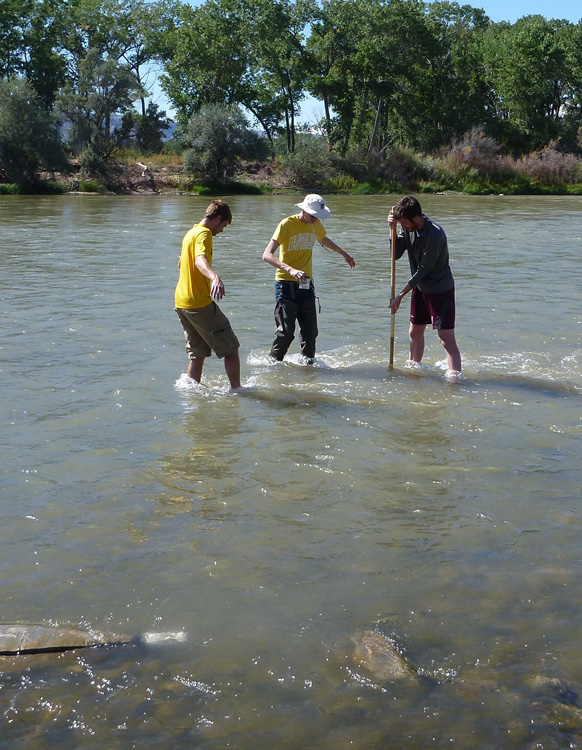



As professors, we are interested in facilitating learning experiences not only in the classroom and teaching lab, but also through research opportunities. Working on research with a faculty member allows students to gain real life experience in experimental design, data collection, specimen identification, specimen curation, and data analysis. These experiences allow our students to be very competitive for entrance to post-undergraduate degree programs, whether they are in ecology, genetics, biochemistry, or in medicine and human health.
Students who are interested in doing research may contact one or more of the faculty mentors listed below.
Research Opportunities in the Department
Colorado Mesa University Internship Program in Biological Research
This internship program provides an opportunity for highly motivated undergraduates and recent graduates to perform hands-on biological research in the summer or during the academic year. Interns work under the guidance of an experienced scientist on real research projects, allowing participants to experience the excitement, challenges, and creativity of research. The Program compensates each summer intern with $6,320 so that they can work full-time during the summer on a project with a faculty mentor. Academic Year interns will receive $3,960 ($1,980/semester). At the end of the experience, interns present their research to the public. Click here to access the Summer 2025 application. Applications are due on March 14th.
Dr. Becktell's research interests are in:
- Plant Pathology
- Mycology
- Horticulture and Greenhouse Management
Dr. Becktell is currently focused on two areas of research. The first area involves research with the plant pathogen Phytophthora infestans. P. infestans causes a disease known as late blight on several members of the potato family, but is most widely recognized for its role in the Irish Potato Famine. While potatoes are the most commonly discussed hosts of P. infestans, tomatoes come in at a close second followed by petunias at a distant third. Of these three most hosts, petunias exhibit a considerable level of resistance to the disease (Becktell et al., 2005) and it is this resistance, or reduced susceptibility, that makes them an interesting host to study. While petunias are not an economically important food crop, understanding how petunias react to and interact with P. infestans does have implications for understanding the interactions that this pathogen has with its more susceptible and economically important potato and tomato hosts.
The second area of research involves work at CMU's Forensic Investigation Research Station (FIRS). The focus of this project is to understand the diversity of fungal species that can be found growing on cadavers during extended decomposition periods under the arid conditions of our high desert climate. Dr. Becktell is working on identifying fungi based on morphology and fungal ITS sequence data.
To hear more about Dr. Becktell's research, check out this CMUnow podcast Plant People
To read more about Dr. Becktell's research with FIRS, check out this publication Identification of fungi found on desiccated human remains in an arid outdoor environment.
Please contact Dr. Becktell if you are interested in working with her on research.
Dr. Connor's research interests are in:
- Ecological Physiology
- Mammalogy
Dr. Connors is interested in uncovering the physiological ways that mammals respond to changes in their environment. In an age of rapid climate change (i.e., rising ambient temperatures, more intense and frequent extreme weather events), it is important to understand the ways that mammals respond to environmental pressures, particularly for wild mammals that require management and conservation plans as well as domesticated mammals that provide key services to humans.
Recent projects in Dr. Connors’s lab have been investigating how small herbivores balance the challenges of eating toxic, plant-based diets with the physiological costs of thermoregulation. Projects incorporate field-based ecological techniques including the deployment of temperature data loggers and identifying sign of rodents and rabbits.
Please contact Dr. Connors if you are interested in working with her on research.
Dr. Hampton's research interests are in the field of:
- Integrative feeding biology of vertebrates
Please contact Dr. Hampton if you are interested in working with him on research.
Dr. Hansen's research interests are in the field of:
- Fish and Freshwater Ecology
- Fisheries and Wildlife Management
- Winter Ecology
- Forensic Sciences
Please contact Dr. Hansen if you are interested in working with him on research.
Dr. McKenney's research interests are in microbial ecology, especially projects involving the diversity of nitrogen fixing bacteria in soils. She has also collaborated with other researchers on a variety of microbiology projects, ranging from water quality determinations to bacterial sensitivity to suspected antibacterial plant extracts.
Please contact Dr. McKenney if you are interested in working with her on research.
Approximately 30% of human tumors bear mutations in genes encoding Ras GTPases, membrane-associated molecular switches that activate intracellular signaling networks in response to extracellular stimuli. To signal, Ras proteins require both post-translational addition of an isoprenyl lipid tail on the C-terminal cysteine residue and methylation of the isoprenyl cysteine. For this reason, clinicians are testing whether drugs that block Ras modifications reduce cell growth and limit tumor expansion. One class of drug that is being evaluated includes compounds that inhibit methylation of Ras proteins. The specific roles that methylation plays in Ras activity are unknown, however, and are the focus of the work done in Dr. McQuade's laboratory.
Dr. McQuade's current research focuses on methylation of Ras family members in the social amoebae Dictyostelium discoideum. Work in his laboratory is aimed at understanding the cellular roles of isoprenylcysteine methylation. Student projects are available that would provide experience and expertise in molecular genetics, biochemistry and cell biology.
Please contact Dr. McQuade if you are interested in working with him on research.
Introduced species usually become invasive in their new habitat due to lack of natural enemies. In the western United States there are several invasive species that have negatively impacted the ecosystem. Biological control agents are living organisms that are used to combat these invasive species. Like their target they are also introduced from another part of the world but are chosen to be highly host specific and effective in controlling – not exterminating – their target.
Dr. Ozsoy's research focuses on several biological control agents that are in use in the west. A few, like the tamarisk beetles and Canada Thistle rust, Puccinia punctiformis, are specifically relevant in our valley. Using molecular biology methods her students focus on identifying and studying these organisms.
To hear more about Dr. Ozsoy's research check out this CMUnow Podcast From Turkey to Tamarisk
Please contact Dr. Ozsoy if you are interested in working with her on her research.
Dr. Sherbenou's interests center around human biology, evolution, and health. The primary focus of her research is the effect of high altitude hypoxia (low oxygen) on humans. This includes both the short- and long-term effects of hypoxia and how the human body adjusts to compensate. Dr. Sherbenou has studied genetic, biochemical, anatomical, and physiological differences among populations (modern human evolution) and between healthy and nonhealthy individuals.
To hear more about Dr. Sherbenou's research, check out this CMUnow podcast High Altitude and Humans: What's the Deal?
Please contact Dr. Sherbenou if you are interested in working with her on her research.
Dr. Stahlke is interested in investigating the genomes of wild systems, from invasive plants like whitetop, to biocontrol agents like tamarisk beetles, and pests, like gregarious locusts. She employs genetic and genomic tools and multi-scale analyses over molecules, space, and time to improve our understanding of the genomic context of rapid evolution in systems of management concern, especially in biocontrol, invasive species, and endangered species.
Dr. Stalhke's recent publications can be found at this link
Please contact Dr. Stahlke if you are interested in working with her on her research.
Dr. Stansbury is interested in how new traits arise and diversify in evolutionary lineages. Since development is responsible for sculpting all morphology, the evolution of novel forms must result from heritable modifications of developmental programs. Dr. Stansbury studies the genetics underlying the development of a spectacular novel feature: the lantern of Photuris fireflies. Current research includes the identification of promising candidate genes via bioinformatic analysis of mRNA sequences derived from pupal lantern bearing tissues, determining the function of these genes using RNA interference, and sequencing and analysis of regulatory regions of genes known through previous research to play a role in lantern formation.
Please speak to Dr. Stansbury if you are interested in working with him on his research.
There are approximately 1.2 million species on earth that are known to science and have been formally described; however, estimates of the actual number of species on earth range from 5-10 million or even higher. This means that there is an incredible amount of biodiversity that we know nothing about!
Research in my lab is focused on understanding biodiversity, including the taxonomy and evolutionary history of various plant groups. I focus on the plant genus Solanum, which includes the eggplant, tomato, and potato and I am also interested in research on local rare plant species in Colorado. Current research includes fieldwork in the western United States, South America, and Central America, as well as laboratory work, including DNA extraction, amplification, sequencing, and phylogenetic analysis. I am also the curator of the Kelley Herbarium at CMU, where students can perform internships helping with identifying, mounting, and data basing herbarium specimens. By studying plants in the field, herbarium, and lab, we can get a better understanding of life on earth.
Please contact Dr. Stern if you are interested in working with him on research.
Research in my lab seeks to understand how mammals respond to anthropogenic disturbances, such as climate change, wildfire or habitat loss. In addressing this topic, we use a combination of behavioral observation, molecular analyses, and habitat suitability surveys. We are currently focused on American pikas (Ochotona princeps), a small mammalian herbivore this is closely related to rabbits and hares. Pikas are typically found in alpine talus (i.e., rockslides and boulder fields) in western North America. Because they are heat-sensitive and have a limited dispersal capacity, climate change has already forced pikas upslope or has lead to local extinction in parts of their range, including southwestern Colorado.
Current projects include investigating pika status and distribution in habitats recently burned by wildfire and testing hypotheses relating to foraging behavior, winter cache quality and pika survival. I am also collaborating with a citizen science project in Oregon to develop a noninvasive acoustic monitoring system that can be used to estimate pika density in typical and atypical habitats.
To learn more about Dr. Varner's research, check out these links:
Meet the cutest animal ever: Pikas!
Spheres with ears, or pikas, and what they say about climate change.
CMU Now Podcast Inspiring Future Generations
Please contact Dr. Johanna Varner if you would like to work with her on her research.
Research in my lab is focused on measuring and understanding patterns of diversity in tropical systems with Lepidoptera as the centerpiece for sampling and measurement. I approach these problems with an interest in quantifying diversity as a spatially dynamic and multifaceted characteristic of communities that can be measured not only by sampling species but also by sampling the trophic interactions between species. This exciting approach to investigating community properties allows inferences to be made that include information about the underlying processes that drive and maintain species diversity in addition to the static quantities presented by taxonomic sampling. I strive to support and mentor undergraduate research students in all aspects of my research with an emphasis on a field course and field work at Yanayacu Biological Station and Shiripuno Research Center in Ecuador.
My current research is funded by "Caterpillars and Parasitoids of the Eastern Andes in Ecuador" a collaborative research grant funded by the Biological Surveys and Inventories of the National Science Foundation ( DOB-0717034). The goal of this project is describe new species of Lepidoptera and their parasitoid wasps and flies while sampling trophic interactions quantitatively on the Andean slope. The lead Principle Investigator of this project is Lee Dyer of the University of Nevada, Reno who brought together a team of people from around the globe to focus on unraveling the mysteries of the neo-tropical lepidopteran caterpillars and their parasitoids and host plants. As a Co-Principle Investigator on this grant I work together with the other Co-PI's Scott Shaw from University of Wyoming, John Stireman from Wright State University, Jim Whitfield from University of Illinois, and Matt Forester from the University of Nevada, Reno. Together this team of collaborators is working to describe new species and unlock diversity patterns of the upper Amazon in Ecuador. This exciting grant has provided funding for undergraduates to gain research experience in Ecuador since 2004.
I have also worked extensively to document patterns of diversity in adult butterflies in the family Nymphalidae. For more than 10 years I have worked with Phil DeVries at the University of New Orleans to monitor fruit feeding nymphalid butterflies in the canopy and the understory at La Selva Lodge on the Napo River in Ecuador. As well I have worked with similar monitoring projects at Limoncocha on the Napo River, and at the Shiripuno Research Center on the Shiripuno River with undergraduate students from Ecuador and the United States.
To hear more about Dr. Walla's research, check out this CMU Now podcast The Fascinating World of Tropical Ecology
Please contact Dr. Walla if you are interested in working with him on research.
Dr. Week's research interests are in:
- Herpetology
- The amphibian pathogen Batrochytrium dendrobatidis (Bd)
Microorganisms living on wildlife can play a crucial role in maintaining overall health of the animal, including outcompeting potential pathogens. For instance, commensal bacteria living on the skin of amphibians can be a coat of armor against the deadly fungal pathogen, Batrochochytrium dendrobatidis (Bd). If the commensal bacteria is disrupted, there may be an increased risk of Bd infection. Bd has been implicated in amphibian population declines worldwide, and we have it right here in Mesa County (based on 2019 data collected from CMU undergraduate researchers in my lab).
Research in my lab currently includes:
- In vitro challenges between bacteria and Bd
- Field surveys of local amphibians to determine prevalence of Bd
- Sequencing bacterial communities from local amphibians
To learn more about Dr. Week's research, check out these links:
Please contact Dr. Weeks if you are interested in working with her on research.
Student research, on my projects, involves the identification and use of gene (DNA) and amino acid (protein) sequence information, and the application of these data to reptile phylogenetics and venom evolution. Students conducting research learn basic techniques of DNA isolation, gene amplification with PCR (polymerase chain reaction), and gene cloning. In addition, students gain experience on how to interpret DNA and protein sequence information with the aid of computer analysis (bioinformatics). Usually, Junior level status and completed coursework in general chemistry, genetics and zoology is required to be considered for student research opportunities.
Please contact Dr. Werman if you are interested in working with him on research.
Receiving College Credit for Research
Under the supervision of a professor, the student can participate in the research while simultaneously earning college credit by taking one of the following courses:
BIOL 387--Structured Research
Under the supervision of a faculty mentor, students learn the techniques associated with the mentor's field of research and collaborate with the professor to collect and analyze data. Students must have the permission of the supervising mentor to enroll in the class, which can be taken for a variable number of credits.
BIOL 487--Advanced Research
After taking BIOL 387, students may continue to refine their skills in research by taking this course. Students continue to delve deeper into the research conducted by the faculty mentor and contribute to the research being conducted by the professor. Students must have the permission of the supervising mentor to enroll in the class, which can be taken for a variable number of credits.
Research Facilities for Cell and Molecular Biology
The Molecular Genetics Research Laboratory at Colorado Mesa University provides the space and equipment for research conducted with undergraduates and for class projects. The research conducted here include projects on the molecular basis for cell motility, the population genetics of polychaetous worms, the molecular phylogenetics of solanaceous plants, and the molecular characterization of biocontrol species. Classes that benefit from the lab include Genetics, Molecular Genetics, Laboratory Investigations in Cellular and Molecular Biology, Evolution, and Forensic Molecular Biology.
Opportunities for Research in Organismal Biology
Students interested in research in the area of organismal biology have the opportunity to conduct research in the field. For example, students have conducted field research on small mammals, reptiles, amphibians, fish, insects, and plants in places that include Colorado, Utah, Idaho, Oregon, Ecuador, and Iceland. In addition to field-based research, students undertaking projects that require more controlled environments have access to the CMU Animal Room, the CMU Greenhouse Facility, and the Walter Almond Kelley Herbarium. These spaces are also utilized by a number of classes including Fish Biology, Mammalogy, Herpetology, Principles of Plant Biology, Plant Anatomy, Plant Physiology, Plant ID, Plant Systematics, and Taxonomy of Grasses.
Student Successes
Chandler Baldwin: Chandler is a middle school Science teacher at American Academy - Motsenbocker campus in Parker, Colorado. Chandler conducted undergraduate research with Dr. Margot Becktell and presented his work at the CMU Student Showcase.
Rachel Baldwin: Rachel is earning her D.O. from Rocky Vista University College of Osteopathic Medicine. Rachel was an undergraduate student and a participant in the Saccomano Internship Program in Biological Research under the supervision of Dr. Zeynep Ozsoy
Marissa Bickel: Marissa is seeking her MS Degree at the University of Northern Colorado. Marissa was an undergraduate research student with Dr. Kyle McQuade during her time at CMU.
Justin Blaskowski: Dr. Blaskowski earned his D.O. from the School of Western University of Health Sciences COMP-Northwest in Lebanon, Oregon. Justin worked with Dr. Margot Becktell as an undergraduate research student and presented his research at the CMU Student Showcase.
Robin Bonner: Robbin is a Fish Culturist with New Mexico Game and Fish. Robin conducted undergraduate research with Dr. Johanna Varner.
Christian Cherry: Christian is a DVM, Ph.D. student studying immunology at Colorado State University. Christian was an undergraduate research student with Dr. Denita Weeks. To read more about Christian's post-undergraduate experiences and his current graduate work, click on this link https://vetmedbiosci.colostate.edu/mip/directory/member/?id=41667.
Kristine Crippen: Kristine worked with Dr. Eriek Hansen as an undergraduate research student and presented her work at the Joint Meeting of Ichthyologists and Herpetologists in Reno, Nevada.
Jacob Eggers: Jacob is a Fisheries Technician for Colorado Parks and Wildlife. Jacob conducted research with Dr. Eriek Hansen
Amber Gillard: Amber is in the Physician Assistant Program at CMU. Amber conducted research under the supervision of Dr. Kyle McQuade.
Austin Hadley: Austin is a middle school Science and Social Studies teacher at Orchard Mesa Middle School. Austin conducted research with Dr. Zeynep Ozsoy and won first place for his track at the CMU Student Showcase.
Heidi Kloser: Heidi spent some time as a research technician at Steadman Philippon Research Institute before starting her Ph.D. program at Colorado State University in Microbiology, Immunology, and Pathology. Heidi conducted research with Dr. Denita Weeks. Click on this link https://vetmedbiosci.colostate.edu/mip/directory/member/?id=41710 to learn more about Heidi and her graduate work.
Molly Kubesh: Molly is earning her M.D./Ph.D. at Creighton University. Molly worked with Dr. Kyle McQuade as an undergraduate research student while at CMU.
Meg Margeson: Meg earned her Physician Assistant degree from Pacific University. Meg worked with Dr. Kyle McQuade as an undergraduate research student at CMU.
Tabitha McFarland: Tabitha worked with Dr. Johanna Varner and presented her work at the meeting of the American Society of Mammalogists held in Washington, DC in 2019. Tabitha McFarland is pursuing a Ph.D. at the University of New Mexico where she’s studying the evolution of lagomorphs and small mammals in South America.
Kristina Morben: Kristina works at the Idaho Fish and Game Clearwater Region in Idaho. Kristina worked as an undergraduate research student under the supervision of Dr. Eriek Hansen and presented her work at the Joint Meeting of Utah and Colorado/Wyoming Chapters of the American Fisheries Society held in Grand Junction, Colorado.
Krystie Murphy: Dr. Murphy earned her D.O. at Liberty University of Osteopathic Medicine. Krystie conducted research with Dr. Zeynep Ozsoy.
Ashley Pennington: Ashley is an Allergy and Immunology Specialist at United Allergy Services. Ashley was an undergraduate student under the supervision of Dr. Zeynep Ozsoy.
Sophia Reck: Sophia, now an MA student in Anthropology at Louisiana State University, worked with Dr. Eriek Hansen as an undergraduate at CMU. Sophia is also a co-author on a paper published on the work she did as an undergraduate. Hansen, E. S., C. Baigent, S. I. Reck, and M. Connor. 2018. Bioelectrical impedance as a technique for estimating postmortem interval. Journal of Forensic Sciences 62(4): 1186-1190. click here to access the paper
Taylor Richardson: Taylor is seeking her graduate degree at Miami University. Taylor worked with Dr. Johanna Varner as an undergraduate student at CMU.
Olivia Sayer: Olivia is pursuing her Ph.D. at the University of Wisconsin-Madison. Olivia was an undergraduate research student under the supervision of Dr. Kyle McQuade.
Amanda Stahlke: Dr. Stahlke completed her Ph.D. in Bioinformatics and Computational Biology at the University of Idaho. Amanda worked as an undergraduate student for Dr. Zeynep Ozsoy. Amanda presented her work at the Riparian Restoration in the Western U.S. Tamarisk Coalition's Research Management Conference held in Grand Junction, Colorado as well as the CMU Student Showcase and the Tri-Beta Honor Society meeting, where she won awards at the regional and national levels.
Selina Tucker: Selina is pursuing her Ph.D. in Biomedical Sciences at the University of North Texas. Selina worked with Dr. Margot Becktell and Dr. Zeynep Ozsoy and presented her work at the CMU Student Showcase.
Tyler Walton: Tyler is a Fisheries Technician with Colorado Parks and Wildlife. Mr. Walton conducted research under the supervision of Dr. Eriek Hansen.
Brooklyn Waterhouse: Brooklyn worked with Dr. Johanna Varner as an undergraduate student. Brooklyn presented her work at the American Society of Mammologists meeting held in Moscow Idaho in 2017 and again at the meeting held in Washington D.C. in 2019. Ms. Waterhouse is also a co-author on a paper based on the work she did on American pikas, Camp, Meghan J.; Shipley, Lisa A.; Varner, Johanna; and Waterhouse, Brooklyn D. (2020) "Activity patterns and foraging behavior of American pikas (Ochotona princeps) differ between Craters of the Moon and alpine talus in Idaho," Western North American Naturalist: Vol. 80 : No. 1 , Article 6. Access the publication here.
Shay West: Dr. West received her Ph.D. from the University of Colorado and is now an instructor at Colorado Mesa University. As an undergraduate, she worked with Dr. Steve Werman.
Katharyn Woodard: Katharyn earned her PA degree from the University of North Texas Health Science Center at Fort Worth. Katharyn worked with Dr. Zeynep Ozsoy. During her time as an undergraduate, Katharyn presented her research at a Tri-Beta Honor Society Meeting and for the CMU Student Showcase.
Brandy Worth: Brandy is an Evidence Technician with the Colorado Bureau of Investigation. Brandy conducted research with Dr. Eriek Hansen.
